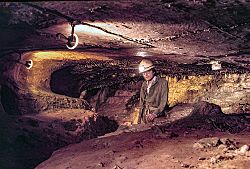Kitley Show Cave facts for kids
Quick facts for kids Kitley Show Cave |
|
|---|---|

A passage within Kitley Show Cave in the 1980s
|
|
| Location | Yealmpton, Devon, [UK] |
| OS grid | SX 57535 51295 |
| Depth | 6 metres (20 ft) |
| Length | 300 metres (980 ft) |
| Elevation | 13 metres (43 ft) |
| Discovery | circa 1834 |
| Geology | Devonian limestone |
| Entrances | 2 |
| Access | Gated |
Kitley Show Cave is a cool cave located in Yealmpton, Devon, England. It's a special type of cave called a "solution cave," which means it was formed by water slowly dissolving rock over a very long time. This cave was first found by accident when people were digging for stone in a quarry. It used to be open for visitors to explore, but it is now closed to the public.
Contents
Exploring Kitley Cave's Passages
Kitley Show Cave is a small part of a much larger cave system. This system is connected to the River Yealm. The cave was uncovered when people were quarrying nearby.
The main part of the show cave has two entrances. These entrances are about 33 meters apart. Both paths lead into the same large, flat room called the Bedding Plane Chamber.
Originally, the passages inside the cave were quite low. But they were made bigger through archaeological digs. The two entrance paths were separate at first. They were connected by digging between 1820 and 1835.
Inside the Cave
The Lower Entrance is on the north side. It's just a little bit above the river. This entrance leads to a short passage. After about 8 meters, you would find a flooded passage on the right. The water level here changes with the River Yealm. This passage becomes completely underwater after about 10 meters.
The main path turns left. It winds along for about 20 meters. Then, some steps on the left lead down into The Bedding Plane Chamber. If you go straight, the passage gets wider. A large passage to the right leads to a pile of rocks. This area used to lead to a chamber about 15 meters high. But that route has since collapsed.
To the left, the main path also enters The Bedding Plane Chamber. This is a low room that covers more than 46 square meters. At the far end, some steps lead into a passage. This passage goes to the Upper Entrance.
Bats in the Cave
Kitley Show Cave is an important home for bats. It's a bat roost. Three types of bats have been seen living here:
How Kitley Cave Was Formed
Kitley Show Cave is a "solutional cave." This means it was formed by water dissolving rock. The rock it formed in is called Devonian limestone. This limestone was laid down about 350 to 400 million years ago.
The cave is also "phreatic." This means it was formed by a river flowing below the water table. The water table is the level below which the ground is saturated with water. Later, sea levels dropped. This left the cave dry. When it was dry, special rock formations called speleothems grew inside. These include stalactites and stalagmites.
Ancient Discoveries
Animal bones found in the cave are very old. They date back to the Eemian period. This was the last time the Earth was warmer between ice ages, about 120,000 years ago. These bones were found in river deposits. They were covered by speleothems. This shows that the caves were active with water and animals back then.
A path was dug through the cave in 1834. Since then, several centimeters of stalagmitic material have grown over it. This shows how slowly these cave formations grow.
A Look at Kitley Cave's History
The Kitley Cave Guide says the main cave was first entered around 1800. This happened when quarry blasting accidentally opened up the entrance. However, other records from that time say it was first entered in 1834. This also happened because of quarrying.
When the cave was first opened, people said it was "beautifully decorated with stalactites and stalagmites." The owner ordered a path to be dug through the floor. This floor was made of stalagmites. During this digging, they found the bones of a very large animal.
By 1905, the cave had a gate. This was to control access. In 1971, it was opened as a self-guided show cave. It had information boards for visitors. It was also part of a nature reserve.
Over the next 30 years, the show cave closed and reopened twice. It was finally closed for good in 2000. During this time, groups like the Plymouth Caving Group explored more of the cave. They extended the Yealmpton Passage to the west. This opened up a new chamber about 15 meters high.
Archaeological Finds in Kitley Cave
Much of the ancient evidence in Kitley Show Cave was lost. This happened when the path was dug in 1835. However, scientists have still found bones from several ancient animals. These include:
- Mammoth
- Rhino
- Horse
- Bison
- Hyena
- Bear
These bones were found in river deposits. They date back to the last interglacial period. This was a warm period about 120,000 years ago.
In other parts of the same cave system nearby, human remains have been found. There were also tools from the Late Magdalenian period. This was part of the Upper Paleolithic (Stone Age). Finds from the Bronze Age have also been made. However, experts believe Kitley Show Cave was too wet for humans or animals to live in during those times.

